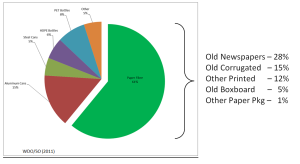
John Mullinder, Executive Director
(Regular posts on environmental and sustainability issues impacting the Canadian paper packaging industry).
How often have you seen this graphic commonly

used to signify Ontario’s Blue Box System? You’d be forgiven for thinking that bottles and cans are the only materials being recovered.
Wrong. Big Time. In fact, plastic, glass and metal containers represent just over 20% of what Ontario’s Blue Box System recovers. The rest (almost 80%) is paper of one kind or another, mainly old newspapers (ONP) and old corrugated (OCC).
The Real Blue Box

And what’s the most valuable material in Ontario’s Blue Box System?
While used aluminum cans are valuable in the sense that their worth in the marketplace is more than their cost to recover, the largest dollar contribution to Blue Box revenues is paper (specifically ONP and OCC). Indeed, if you put all paper together, sales of used paper fibre represented an impressive 61% of the total value of all Blue Box materials in 2011, the latest year for which data exists.

Of course, in provinces with beverage deposit programs, the dollar contribution to a Blue Box system from aluminium, steel, glass and plastic containers is greatly diminished, making the maximising of paper revenues even more important.
